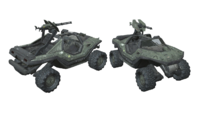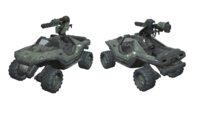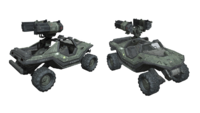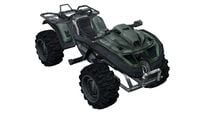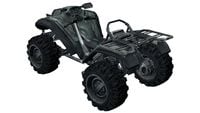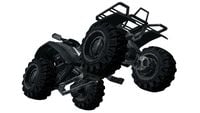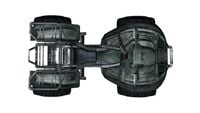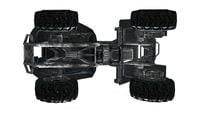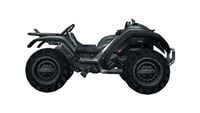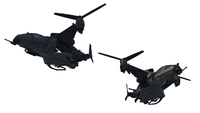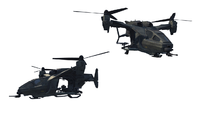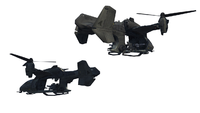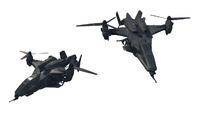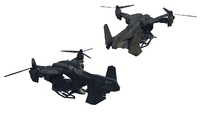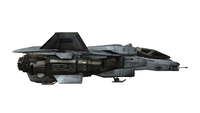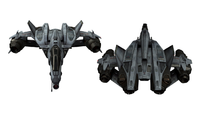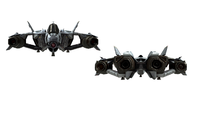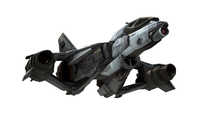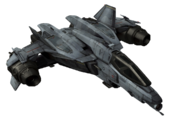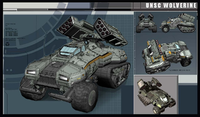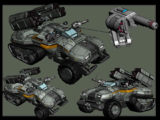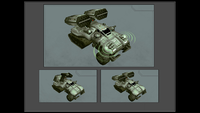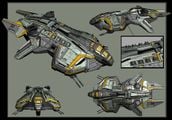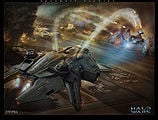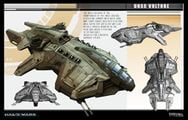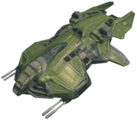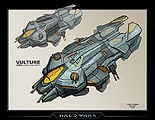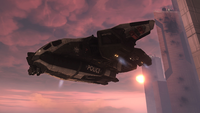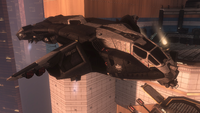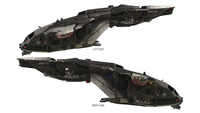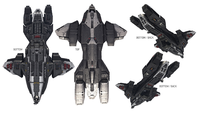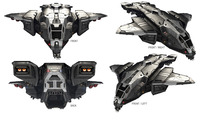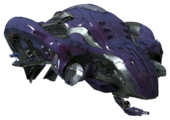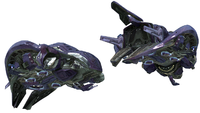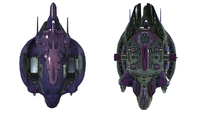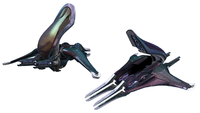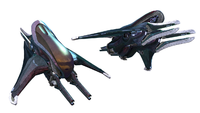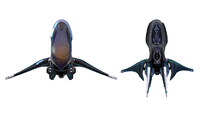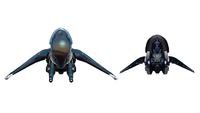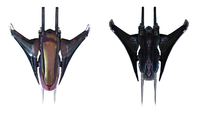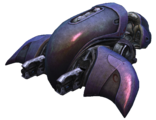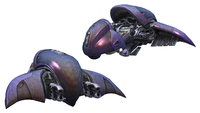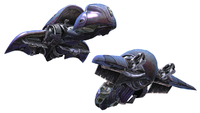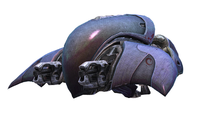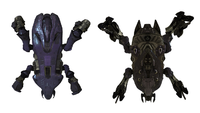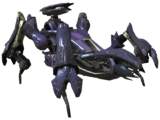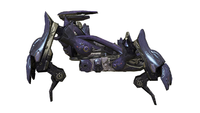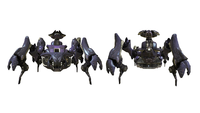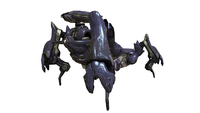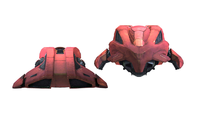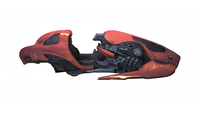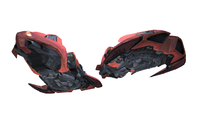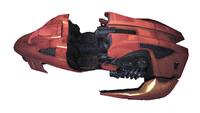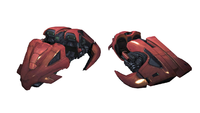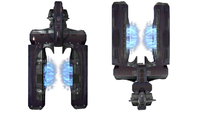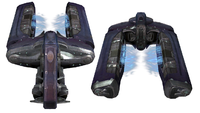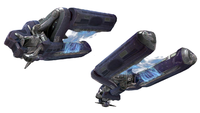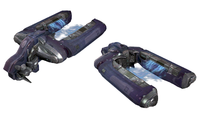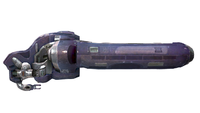Archive:Halo Waypoint/2009 to 2014/Universe/Vehicles: Difference between revisions
From Halopedia, the Halo wiki
m (Bot: Automated text replacement (-^ +{{Status|Archive}}\n)) |
m (→[[FSS-1000 Sabre|Sabre]]: Link cleanup) |
||
| Line 70: | Line 70: | ||
*'''Source''': [http://www.halowaypoint.com/en-us/universe/detail/3c8b0600-f216-4195-81dd-3eb10cf7ca38/falcon '''Halo Waypoint''': ''UH-144 Falcon''] (defunct, backup on [https://web.archive.org/web/20110314221131/http://halo.xbox.com/en-us/intel/theuniverse/tech/gallery/falcon/3c8b0600-f216-4195-81dd-3eb10cf7ca38 Archive.org]) | *'''Source''': [http://www.halowaypoint.com/en-us/universe/detail/3c8b0600-f216-4195-81dd-3eb10cf7ca38/falcon '''Halo Waypoint''': ''UH-144 Falcon''] (defunct, backup on [https://web.archive.org/web/20110314221131/http://halo.xbox.com/en-us/intel/theuniverse/tech/gallery/falcon/3c8b0600-f216-4195-81dd-3eb10cf7ca38 Archive.org]) | ||
==[[ | ==[[FSS-1000 Sabre|Sabre]]== | ||
{{Article quote|YSS-1000}} | {{Article quote|YSS-1000}} | ||
Revision as of 17:51, April 11, 2022
| The following is a verbatim transcription of an official document for archival reasons. As the original content is transcribed word-for-word, any possible discrepancies and/or errors are included. |
Warthog
| “ | M12 Force Application Vehicle | ” |
Perhaps the most recognizable piece of hardware in all of the UNSC, the M12 FAV is extremely versatile in both maneuverability and offensive functionality. Typically carrying one driver, one passenger, and a rear gunner (though variants may differ), the Warthog excels at scouting and reconnaissance, while still remaining effective at applying direct force to enemy infantry and armor.
The Warthog is roughly three metric tonnes, fueled by a 12.0 L liquid-cooled hydrogen-injected ICE and can reach speeds of up to 125kph (78 mph). Apart from its consistent performance in the field, the wide diversity of arms it carries give it an excellent range of possible applications. The predominant examples of this can be seen with the three core models:
- LRV (Light Reconnaissance Vehicle) with an M41 12.7mm LAAG
- LAAV-G (Light Anti-Armor Vehicle, Gauss) with an M68 25mm ALIM
- LAAV-R (Light Anti-Armor Vehicle, Rocket) with an M79 65mm MLRS
While these are the UNSC’s primary configurations for the M12, other versions exist and achieve similar levels of success with their varied roles: carrying troops, supplies, and arms; acting in medical, reconnaissance, and communication roles; or lastly, participating in excursions in extreme weather and/or terrain conditions. All-in-all, the Warthog is the most reliable and the most appreciated piece of equipment throughout all of the UNSC’s armory.
- Source: Halo Waypoint: Warthog (defunct, backup on Archive.org)
Mongoose
| “ | M274 ULTRA-LIGHT ALL-TERRAIN VEHICLE | ” |
In the UNSC’s fleet of ground vehicles, the M274 ULATV, or Mongoose, is fairly unique in that it bears no formal armament. The Mongoose is usually deployed for transportation of personnel or cargo across relatively short distances and is particularly useful in areas where the terrain is varied and otherwise unnavigable by traditional vehicles.
The M274 touts a 1000cc liquid-cooled, longitudinally mounted, four-stroke, hydrogen-injected internal combustion engine, allowing it to maximize its speed at 96kph (60 mph), even in varied terrain. The Mongoose is second to only the Warthog in swift and nimble transportation, sometimes superseding the Hog due to its maneuverability in tightly confined environments, whether that be a dense urban city, a rocky, canyon floor or even the equipment hangars of capital ships.
At just over three meters in length and approximately 400 kilograms, the Mongoose seats one driver and sports a rear cargo rack which can carry weapons, equipment and, if the stirrup tracks are engaged, a passenger. In this configuration, the passenger can fire a weapon from the rear of the M274, effectively arming the vehicle. Field observations have indicated that when two Spartans are operating a Mongoose in this way, it becomes truly formidable, eclipsing its role of basic transportation and becoming something more akin to a force application vehicle.
- Source: Halo Waypoint: Mongoose (defunct, backup on Archive.org)
Falcon
| “ | UH-144/Primary air-to-ground support/transport VTOL | ” |
Within the UNSC, there is no shortage of vertical take-off and landing craft—after all, they’re agile, versatile, and effective when appropriately leveraged. But unlike the heavy D77-TC Pelican, the beastly AC-220 Vulture gunship, the nimble AV-14 Hornet, or the swift AV-22 Sparrowhawk, the UH-144 Falcon is exceptionally discrete, while remaining incredibly effective.
The Falcon’s open cabin, its relatively heavy weaponry, and its maneuverability make it an equally viable option for the tight confines of a narrow gorge, a dense forest, or even a skyscraper-laden cityscape. The pilot resides in a closed cabin, while the crew have their choice of two gunner seats in extended buckets, two passenger seats, an aft bench, and a limited amount of standing room. A pair of Falcons can easily and quickly transport a fully-equipped infantry squad, making it one of the most popular transports within the UNSC Army.
In terms of firepower, fixed below the pilot’s main cabin is an M638 20mm auto-cannon and flanking the vehicle on both sides are modular turrets depending on the Falcon version in use: either the UH-144A or the UH-144S models. The former includes a pair of M460 automatic grenade launchers, while the latter sports standard M247H 12.7mm heavy machine guns. Both have been incredibly effective against Covenant Banshees and providing point-to-point suppressive/attack fire on enemy ground emplacements and infantry.
- Source: Halo Waypoint: UH-144 Falcon (defunct, backup on Archive.org)
Sabre
| “ | YSS-1000 | ” |
Highly-classified—to the extent that three prior administrations adamantly denied its existence—the Sabre program offers the UNSC’s best option for swift, versatile, and lethal planetary defense. Developed for fighter combat against enemy forces in orbit above Inner Colony worlds, the YSS-1000 or "Sabre" is extensively equipped with a heavy arsenal, a cabin for two operators, and the ability to be launched from a planet’s surface without the use of asynchronous linear-induction, traditional nuclear technology, or other conventional means of off-world transit.
The Sabre is built for the dual purposes of peak acceleration and maneuverability in orbital combat, accomplishing some feats that many ground-to-space-capable vessels are simply incapable of. Its armament further enhances its combat appeal, carting twin M1024 ASW/AC 30mm MLAs and a pair of ST/Medusa missile pods. As such, this craft is intended specifically for lethal encounters, not simply to disrupt, disable or maim targeted craft.
Across the Inner Colonies, there are several well-hidden launch sites, the newest lying on the banks of Farkas Lake on Reach. Apart from their top-secret locations and heavy array of gun batteries, these sites are largely standard launch complexes, consisting of multiple bays, each with various maintenance tiers and control decks. Despite its internally-lauded performance against a Covenant Corvette and, by extension, the supercarrier Long Night of Solace just prior to Reach’s demise, the Sabre project remains a well-guarded secret.
- Source: Halo Waypoint: Sabre (defunct, backup on Archive.org)
Wolverine
| “ | M9 Wolverine MAAT | ” |
The Wolverine Main Anti-Aircraft Tank (official designation: M9 Wolverine) is somewhat of an enigma within the UNSC in that it is not used as a “tank” in the standard hard-hitting, hard-armored tradition. Its classification is based chiefly on the vehicle’s historical development alongside the Main Battle Tanks currently employed by the UNSC—but only with regard to its general architecture and framework. When reviewing the actual arsenal employed by the Wolverine, one can quickly see why such a classification is vestigial, though relevant on the battlefields on which it is deployed.
Central to the Wolverine’s arsenal is the MLRS or Multiple Launch Rocket System, which has seen many different forms of military use since the mid-to-late-20th century. Birthed from the antiquated GSRS (General Support Rocket System), this technology was created through a joint effort among a variety of nations across Earth. With regard to the Wolverine, its multiple-pod implementation can fire a bevy of Argent V missiles toward enemy aircraft—an incredibly powerful and effective force when used strategically and en masse.
Ancillary to the twin pods, the M9 Wolverine has incorporated a dorsal-mounted pivoting XM511 grenade launcher. While nowhere near as potent as an MBT’s cannon, this weapon supports its primarily anti-air Argent component by clearing the ground of infantry and heavy armor in areas where Scorpions or Grizzlies have not been deployed. In moments of desperation, some Wolverine commanders have even turned their anti-air missiles groundward as makeshift, but devastating, close-range artillery.
Over the years, the Wolverine has consistently proven itself in combat—particularly during the war with the Covenant, where mobility and heavy firepower was a significant requirement.
- Source: Halo Waypoint: M9 Wolverine MAAT (defunct, backup on Archive.org)
Vulture
| “ | AC-220 Vulture Gunship | ” |
Easily the largest in its class, the AC-220 Vulture gunship is the preferred aerial combat vehicle of the UNSC during protracted air-and-ground engagements, particularly when addressing a heavily-fortified enemy stronghold. Its contemporary, tank-like design was conceived in 2498 to curtail the spreading rebellion in the Outer Colonies—although its core attributes have been present since the AC-47, AC-130, and AC-163 five hundred years earlier.
The Vulture is not a remarkably fast vehicle, but it can be mobile and even more so, functionally effective, within a 360-degree radius chiefly due to its VTOL directed-thrust propulsion systems and its dorsal A-74 armament. Additionally, the craft has a heavy, titanium-based plating which makes it extremely dominant in aerial encounters, even against the Covenant’s imposing armament.
The materiel components of the AC-220 are as robust as they are intimidating. Extending from its fore undercarriage are a series of GUA-23/AW/Linkless Feed Autocannons which can directly fire into infantry and light armor, shredding it where it stands. On its back are two self-guided missile emplacements: the A-74 Sylver Vertical Missile Launcher and the dual Argent V missile bays; both are specifically tailored to unleash a unified barrage on a target, overwhelming any energy or armor shielding it might have. The net results of such a combined arsenal are, as expected, extraordinarily destructive.
The UNSC’s AC-220 Vulture requires highly-trained pilots and can service a crew of six. The gunship was effective in combat against the Covenant, but due to their size, lack of radioactive shielding needed for space travel, and general manufacturing cost they were only used in key battles in that war.
- Source: Halo Waypoint: AC-220 Vulture gunship (defunct, backup on Archive.org)
NMPD Pelican
| “ | D77 Civilian Pelican - New Mombasa Police Department | ” |
If one could trace back the intermingling of the civilian sector with the United Nations Space Command, they would likely find themselves during the throes of the Interplanetary War hundreds of years before the war with the Covenant. This earlier conflict sowed the seeds for such materiel compromises in the 26th century as the D77C-NMPD, the New Mombasa Police Department’s Pelican dropship.
Very few modifications have been made to the D77C over the existing D77H model, beyond the superficial color scheme and minor chassis alterations. The standard Pelican’s missiles and guns have been completely removed, replaced for civilian use with optical and sensory surveillance systems for the tracking and seizing of fugitives as well as addressing large-scale emergencies. For situations such as natural disasters, terrorist attacks, riots or other strategic integrations which would require a heavily armored vehicle for airborne transportation, nothing comes close in utility to a Pelican.
During the Covenant’s initial invasion of Earth, the local D77C-NMPD dropships were a lifesaving element of the evacuation effort, and they later facilitated the military operations which followed the New Mombasa Slipspace Event.
- Source: Halo Waypoint: D77C-NMPD Pelican (defunct, backup on Archive.org)
Phantom
| “ | TYPE-52 TROOP CARRIER | ” |
The Phantom is one of the Covenant’s primary methods of infantry transportation and deployment in both atmospheric and exoatmospheric environments. The T-52 Troop Carrier is composed of a circular central hull with a closed operator cabin in the fore and a pair of twin turbines set into the craft’s outer edges, which contour up and back into the shape of aerodynamic fins. On both sides lie open bay doors and below a ventral gravity lift, all three allowing swift and relatively painless infantry deployment in nearly any terrain type.
Slightly larger than the UNSC’s Pelican from nose to tail, the Phantom is capable of transporting up to 30 passengers, a number which is contingent, however, on personnel size. While it is wider than the Covenant’s more traditional Spirit dropship, the Phantom is significantly more maneuverable, particularly in tightly-cropped environments like narrow gorges, caverns or even the urban warrens of a human cityscape.
Though they are rarely deployed in a gunship role, Phantom’s tote an impressive armament, with a single heavy plasma cannon located underneath its nose and twin, flanking T-52 DESW (Directed Energy Support Weapons) propped in the dropship’s open bay doors. In addition to this, the Phantom can utilize its gravity lift for towing purposes, carrying a variety of vehicles into the battle including the Covenant’s heavy mortar tanks, the T-26 Wraith, which bring even more firepower to the fight.
- Source: Halo Waypoint: Phantom (defunct, backup on Archive.org)
Banshee Fighter
| “ | Type-27 Exoatmospheric Multi-role Fighter | ” |
First observed in 2527, the Banshee Fighter is one of the Covenant’s several multirole spacecraft. Its overall framework and architecture are typical of Covenant design, bearing the same swooping contours and organic segmentation seen across the aliens’ matériel and structures. Though it appears to share many architectural design features with the T-26 Banshee, its overall profile and its individual parts are wholly unique to the craft.
The T-27 Banshee’s wings feature a similar-looking lift-generating canard system, but they are swept forward and mechanically altered to make the craft incredibly maneuverable within the zero G, vacuum conditions of space. The fighter also features an extended tail stabilizer which dampens turbulent transitions in and out of atmospheric conditions when docking. The most prominent characteristic of the T-27 is likely its twin heavy plasma cannons’ extended firing channels, two large weapons affixed to the frontend of the craft. This system improves the distance and performance of the plasma bolt in space dogfights which occur over significantly larger area than the T-25’s combat scenarios.
Though an individual Banshee Fighter is an effective vehicle against stationary weapon emplacements and EVA-equipped infantry, or even in the establishment of recon pickets, its greatest strength is clear when it is deployed in large numbers. With high-volume deployments, the T-27 can overwhelm heavier-armed fighters and even larger ships, like human frigates and cruisers. And while Covenant naval forces rely primarily on Seraph fighters for single ship combat, the Banshee Fighters can often play a critical role in interception, interference, and distraction, tipping the scales of most large-scale space battles in the Covenant’s favor.
- Source: Halo Waypoint: Banshee Fighter (defunct, backup on Archive.org)
Ghost
| “ | Type-32 Rapid Attack Vehicle | ” |
Perhaps the most commonly used vehicle in the Covenant arsenal is the Type-32 RAV or Ghost, an incredibly swift and agile single-pilot craft with an armament well-suited for assaulting opposing infantry and, when necessary, even fortified enemy positions. The craft’s most prominent use, however, has been that of reconnaissance, allowing the front line of any Covenant military incursion to have quick and solid intel with low risk to the accompanying forces.
Unlike the T-25 AGC Wraith or the T-48 LAGC Revenant which utilize a plasma mortar mechanism as their primary armament, the Ghost fires a pair of lower grade, but significantly faster class-2 directed energy cannons. With two of these girding the Ghost’s air dam, the twin weapons can be used formidably either up close or at range, though even the front of the vehicle itself can also be used as an effective battering ram. Since the vehicle can reach impressively high speeds out in the open, it can be particularly devastating to high concentrations of enemy infantry.
The Ghost uses a boosted gravity propulsion drive which is standard among most Covenant infantry support vehicles, though this specific drive set has been tweaked to offer smoother versatility and mobility rather than raw power. The dual combination of speed and armament make the Ghost an exceptional asset for a wide variety of military endeavors, which is repeatedly evidenced by its frequent use across most theaters of war.
- Source: Halo Waypoint: Ghost (defunct, backup on Archive.org)
Scarab
| “ | T-47 Ultra Heavy Assault Platform | ” |
No other Covenant vehicle can manage to strike the same level of fear in an opponent as the T-47 UHAP Scarab—a heavily-fortified and incredibly dexterous mobile platform capable of carrying substantial numbers of enemy infantry while still providing impressive levels of firepower. The Scarab was originally designed for excavation purposes on widely varied terrain, its maneuverability coupled with its primary weapon, an ultra-heavy focus cannon, made it especially useful for uncovering artifacts of worth.
Though it is still considered by many to be a heavy vehicle, recent intelligence reports seem to indicate that the Scarab is a single biological entity with extensive armor, comprised almost entirely of Lekgolo eels, the same species which take the form of Hunters. The creature is fused into the carapace and appendages in cavernous assemblies such as High Charity. The Scarab is modularly crafted on an assembly line like any other vehicle, its various pieces combined then activated.
At the end of their production, the Covenant typically equip the Scarab's prow with an ultra-heavy focus cannon, an ultra-heavy plasma cannon on the adaxial-aft of its carapace, and a trio of mounted T-52 plasma cannons. This, of course, in addition to the standard crew of one pilot and five defenders. Rather than steer the T-47, the pilot “guides” the beast and directs the artillery when needed. The Scarab has the deck capacity to hold up to twelve defenders, with reasonable combat efficiency, at any given time.
And while the T-47 UHAP is harrowing to behold, it is not without a weakness. At the rear of the carapace is a shielded power core, one of the only locations where the vehicle’s true form—the Lekgolo collective—can be seen. Several well-placed shots can break the shield and tear the creature’s tissue, initiating a chain reaction which will quickly destroy the craft. The act of bringing down a Scarab platform may not be a common occurrence in combat, but they do occur and are usually executed in some shape or form by a Spartan.
- Source: Halo Waypoint: Scarab (defunct, backup on Archive.org)
Revenant
| “ | T-48 Light Assault Gun Carriage | ” |
The Covenant command an array of vehicles custom-tailored for a variety of combat situations, hammered into existence through centuries of war and bloodshed. For some time, the T-32 RAV Ghost has been predominantly used for swift attacks and reconnaissance while the T-26 AGC Wraith has run the gamut of heavy ground assault types—but the role found in between has been somewhat difficult to fill. The T-52 ISV Prowler, operated exclusively by the Jiralhanae and the T-46 ISV Spectre, which saw intermittent use in recent years, were both attempts at a solution; but neither held popular favor. Enter the T-48 LAGC Revenant.
The Revenant is a lightly-armored mobile artillery vehicle which simultaneously leverages the speed and maneuverability of the Ghost with the heavier brand of firepower that the Wraith commands. Rather than fire pulsed bursts of plasma energy in rapid succession, the Revenant utilizes a slightly weaker plasma mortar, trading its bigger brother’s vicious armament for size, speed, and agility.
In addition, its ability to boost forward at a high velocity and the craft’s well-armored nose combine to make it incredibly useful against close-range infantry in an open environment. Its only real drawback is that both the operator and the passenger are exposed at all times. But among Covenant vehicles, this is not an uncommon design element, likely due to the aliens’ heavy reliance on personal energy shields.
In the end, it is probable that the Revenant will supersede the other Infantry Support Vehicles, perhaps even coming to rival the Ghost and the Wraith over time.
- Source: Halo Waypoint: Revenant (defunct, backup on Archive.org)
Spirit
| “ | T-28 TC/PRIMARY TROOP CARRIER | ” |
The ability to effectively invade an opposing force’s occupied territory is fundamental to the success of the Covenant military’s modus operandi. For such purposes, they have a wide variety of troop deployment options available: gravity-manipulated lifts from capital ships, teleportation spires for large-scale, surgical infiltrations, and specialized drop pods for Elite combatants are some of the more exotic—but such methods are not always the most practical for the duration of a protracted military campaign.
Enter primary troop carriers, of which the Covenant have two predominant versions: the T-52 Phantom and the T-28 Spirit. Heavily-armored and capable of carrying up to thirty passengers, the Spirit is one of the most common Covenant vessels seen in combat. Though it lacks the local gravity lift of the Phantom, its armored carapace has historically provided better protection for its troops—they are never exposed prior to deployment.
Below its aft armature, where the pilot’s cabin is situated, is a heavy plasma cannon which can offer extensive suppressive fire when the ship is engaged in a deployment action. And similar to the Phantom, the Spirit can deploy vehicles into combat—either two smaller craft or a single, heavy one.
Despite the size and unique shape of the Spirit, the Covenant have used it well over the course of the war—its deft maneuverability and fortification make it a critical asset to the Covenant’s war machine and a powerful force against the UNSC resistance.
- Source: Halo Waypoint: Spirit (defunct, backup on Archive.org)

